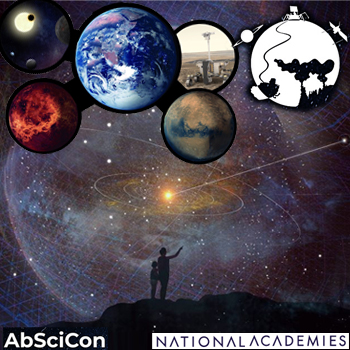CAPS and AbSciCon24 Astrobiology Meetings Share Progress, Plans for Next-Gen Exploration Missions
|
MONDAY☆ May 13 — International Space Station, ~415-km LEO: Expedition 71 seven-member crew expecting arrival of Starliner CST-100 this weekend, working with pharmaceutical, antimicrobial & fuel combustion experiments, participating in in-flight events with KMGH-TV Denver, Pima Community College Arizona, New York Hall of Science. ☆ May 13 — Tiangong Space Station, ~390-km LEO: Shenzhou 18 three-member crew continue working with cargo / experiments, are planned to perform 2-3 extravehicular activities during 6-month mission; over 400 material samples exposed to space brought back to Earth by Shenzhou 17. Highlights… o NewSpace: Portal Space Systems of Seattle promises 50x increase in satellite maneuverability between LEO and cislunar space with solar-thermal propulsion Supernova satellite bus; Rocket Lab preparing for static-fire of Archimedes methalox engine at Stennis Space Center ahead of NET 2025 Neutron launch; Starfish Space to further develop in-space docking technology with US$37.5M USSF contract following successful rendezvous with D-Orbit ION SCV006 satellite. ☆ Solar System: Several X-class flares evidence of space weather increasing intensity ahead of NLT 2026 11-year solar cycle maximum; CNSA operators at Beijing Aerospace Flight Control Center working to determine optimal time for Chang’E-6 lander / ascender separation in lunar orbit; UC-Boulder study posits formyl cation (HCO+) in Venus atmosphere causes hydrogen in water to escape into space. ☆ Galaxy: Thermal emissions measured with JWST NIRCam and MIRI suggest rocky exoplanet 55 Cancri e (41 ly distant) may hold an atmosphere; NASA / JAXA XRISM observing SMBH at center of galaxy NGC 4151 reveals iron emissions lines at ~ 6.5 keV. o Global: National Space Council of Canada to be co-chaired by Canadian Space Agency and Department of National Defence; ISRO of India working to ensure its missions do not leave debris in space by end of decade; ispace (Japan) to carry 275 languages to Moon for UNESCO on Resilience lander NET winter 2024. ● USA: Astronaut / former JSC director Ellen Ochoa and JWST astrophysicist Jane Rigby among latest recipients of Presidential Medal of Freedom; Virgin Galactic building Delta-class fleet of horizontal-launch spacecraft in new Orange County facility ahead of NET 2026 inaugural launch; 4 teams selected to conduct 1-year, $5M concept studies under NASA Earth System Explorers Program, 2 will be developed into space missions ready for launch NET 2030/2. ● Hawai’i: Magnetic field detection instrument at CFHT receives name Wenaokeao (‘earliest glow of light’ in ʻŌlelo Hawaiʻi) via A Hua He Inoa program at ʻImiloa Astronomy Center; Privateer of Maui acquires Orbital Insight, raises $56.5M in funding round led by Aero X Ventures, and plans launch of SSA platform in ~6 months. |
 |
● = Terrestrial and… o = International terrestrial events
☾ = Moon activity ★ = Space and… ☆ = International space / astro events in Hawaii Standard Time unless noted. Add 10 hours to obtain UT (‘Universal Time’). |
Weekly Planet Watch – Morning Planets: Mars (ESE), Saturn (ESE).
India Issues Guidance on Space Policy, Streamlining Commercial Space Regulation
|
● May 13-14 — Arizona State University / New America, Online: Space Intersections Symposium: How will religious and political ideologies define the future of human expansion into space? ● May 13-15 — NASA Extraterrestrial Materials Analysis Group, Houston TX / Online: ExMAG Meeting; at Lunar and Planetary Institute. ● May 13-15 — Smarter Shows, Long Beach CA: Space Tech Expo USA. ☾ May 13 — Moon: 3.5° NNE of Beehive Cluster, 16:00. ☆ May 13 — Apollo Asteroid 2024 JB2: Near-Earth Flyby (0.029 AU) TUESDAY☆ May 14 — Tianwen-1 Lander, Utopia Planitia, Mars Surface: China Tianwen-1 Lander reaches 3 full years / enters 4th year of Mars surface operations at / near 25.1°N, 109.9°E; landed 2021 with Zhurong Rover. ★ May 14 — SpaceX, Launch Falcon 9 / Starlink 8-7, SSLC-4E, Vandenberg SFB CA: Next batch of Starlink satellites to launch for SpaceX constellation. ● May 14 — Lunar Exploration Analysis Group, JHUAPL, Online: LEAG ExComm Community Meeting. o May 14-15 — U.N. Office of Outer Space Affairs (UNOOSA), Portuguese Space Agency, Lisbon, Portugal: Conference on Management and Sustainability of Outer Space Activities. ☆ May 14 — Apollo Asteroid 2014 WF6: Near-Earth Flyby (0.018 AU) WEDNESDAY
|
FRIDAY
★ May 17 — United Launch Alliance, Boeing, Launch Atlas V / CST-100 Starliner Crew Flight Test, SLC-41, Cape Canaveral SFS FL: Boeing to launch Astronauts Sunita Williams and Butch Wilmore to ISS on first crewed flight of Starliner.
☾ May 17 — Moon: At apogee, distance 404,630 km, 09:00.
☆ May 17 — Mars and Saturn: At heliocentric conjunction, 05:00.
☆ May 17 — Apollo Asteroid 2022 WN2: Near-Earth Flyby (0.035 AU)
SATURDAY
☆ May 18 — Venus: With Jupiter and Uranus within circle of diameter 4.86°, 02:00; 0.45° SE of Uranus, 03:00.
☆ May 18 — Jupiter: At conjunction with Sun, 6.027 AU from Earth, 09:00.
☆ May 18 — Asteroid 2 Pallas: At opposition in longitude, magnitude 8.9, 13:00.
☆ May 18 — Aten Asteroid 2024 GQ7: Near-Earth Flyby (0.014 AU)
SUNDAY
★ May 19 — SpaceX, Launch Falcon 9 / NROL-146, SLC-4E, Vandenberg SFB CA: Falcon 9 to launch the first (of up to 6) launches of SpaceX-Northrop built satellites for National Reconnaissance Office.
☆ May 19 — Amor Asteroid 2024 GQ7: Near-Earth Flyby (0.057 AU)

